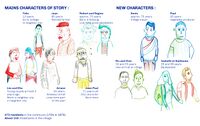LED2LEAP 2020 - Budapest
Jump to navigation
Jump to search
>>>back to working groups overview
Landscape Democracy Rationale
- The Primary School No.1 in Budaörs is the newest school of the city. It was build in 2009 and designed by the Dobai Architecture Studio and S73 Landscape Architecture Studio. At first sight this is a school without any problems, it has a very modern look and an innovative spatial structure. But because no community was connected to the building when it was established, the designers didn't have the chance to ask the users opinions and viewpoints. Nowdays we can see what kind of problems the school community has and how they would imagine their school in the future. Since we are landscape architects, primary we will focus on the schoolyard, but we also believe that this is the place where the most important scenes of the school life are taking place.
Location and scope
- You can edit this map with the map editor
- Next to showing us where you are, you may also use this map to localise different focus themes of your community
Phase A: Mapping your Community
Welcome to your community and its landscape
- The Primary School No.1 in Budaörs is the newest school of the city. It was build in 2009 and designed by the Dobai Architecture Studio and S73 Landscape Architecture Studio. At first sight this is a school without any problems, it has a very modern look and an innovative spatial structure. But because no community was connected to the building when it was established, the designers didn't have the chance to ask the users opinions and viewpoints. Nowdays we can see what kind of problems the school community has and how they would imagine their school in the future. Since we are landscape architects, primary we will focus on the schoolyard, but we also believe that this is the place where the most important scenes of the school life are taking place.
Groups of actors and stakeholders in your community
- Which groups/sub-communities are there? What are their needs and aspirations with regard to the landscape? Which groups are more visible? Which are less visible? What do we not know? (max 200 signs)
- add 1-2 graphical representations to the image gallery based on your PPT presentation, you can add more if you like
Relationships between your actors and groups
- How would you describe the power relationship between the groups?
- Which groups may have shared interests and which are these? (max 200 signs)
- add 1-2 graphical representations to the image gallery based on your PPT presentation, you can add more if you like
Summary of your learnings from the transnational discussion panel on April 22
On April 22 you will present the PPT version of this first assignment to other seminar groups working in other geographical community contexts. Please give here a short summary of your learnings during this presentation, for example:
- Other analytical approaches
- Other representation styles
- Other value schemes: any surprises?
- Constructive comments we received on our presentation
Theory reflection
- Reflect on at least three readings from the first section 'Democratic Landscape Transformation
- You can choose references from our reading list or suggest others
- Scope: 250 words
References
- give a full list of the references you have used for this section
Phase B: Democratic Landscape Analysis and Assessment
The Scene in your Story of Analysis
- Describe your landscape democracy challenge. What is the physical scene, specific description of the landscape? What are the socio-economic and political characteristics of place? Are there any important contextual elements?
- add the corresponding visual from your presentation to the image gallery below
- Yourcase scene1.jpg
add a caption
The Actors in your Story of Analysis
- Describe the characters and their role in the story. Are they major or minor characters? Are there any key relationships that need to be defined?
- add the corresponding visual from your presentation to the image gallery below
The Story of Analysis
- Describe the plot of the story and how it plays out.
- add the corresponding visual from your presentation to the image gallery below
- add as many additional images as you like
- Yourcase story2.jpg
add a caption
Reflect on your Story of Analysis
- How did the tools you chose for landscape analysis fit your community? Reflect on the questions: What did you carry? Why did you carry? How did you carry? What remains after you've left? (150 words)
- add the corresponding visual from your presentation to the image gallery below
- Yourcase refelction1.jpg
add a caption
Phase C: Collaborative Visioning and Goal Setting
* template coming
Phase D: Collaborative Design, Transformation and Planning
* template coming
Phase E: Collaborative Design, Transformation and Planning
* template coming
= Phase E: Collaborative Evaluation and Future Agendas * template coming
Process Reflection
- Reflect in your intercultural and interdisciplinary team on the outcomes of your study
- Which limitations were you facing?
- What have you learnt from each other?
- What would you do differently next time?
- You can also use diagrams/visuals
- 250 words text









